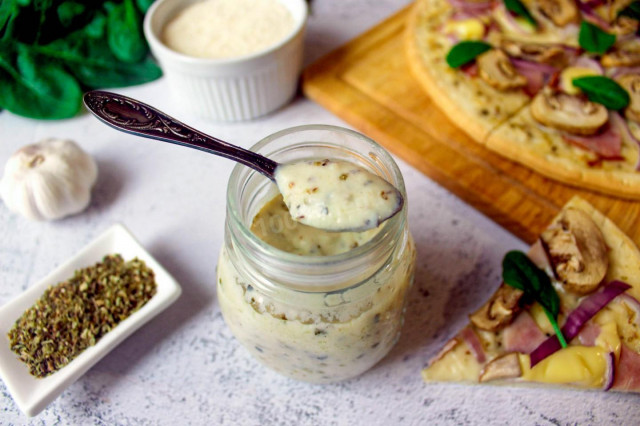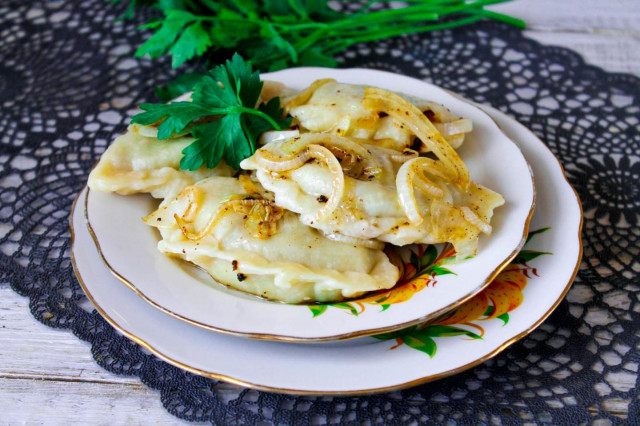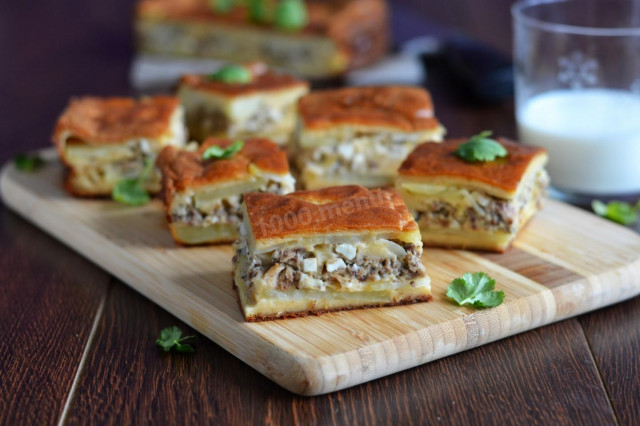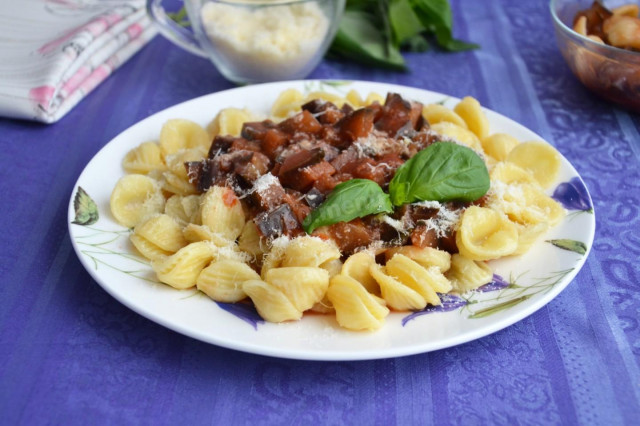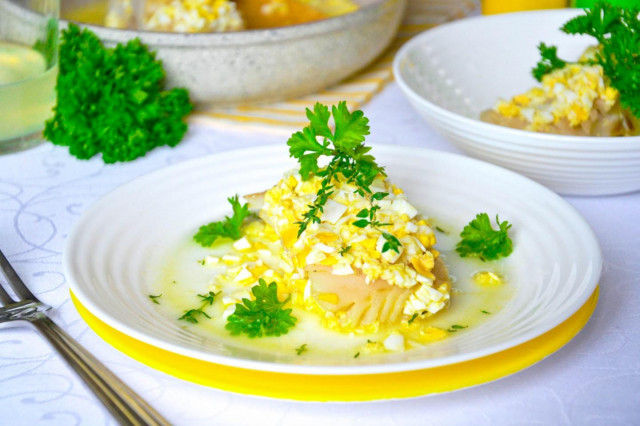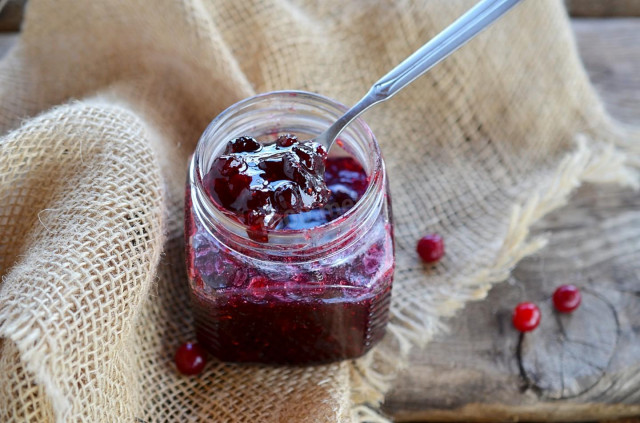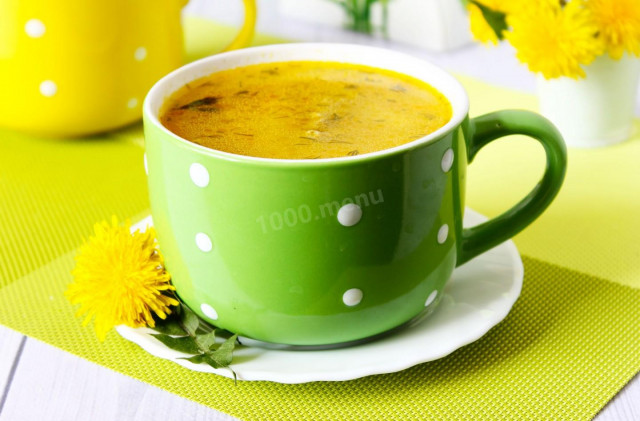Composition / ingredients
Step-by-step cooking
Step 1:

How to make white pizza sauce? Prepare all ingredients. Milk is better to take from the refrigerator, the sauce will be thicker and homogeneous. As a hard cheese, it is better to choose parmesan. What could be more Italian? In addition, it has a rich taste. It is also better to use nutmeg in its whole form, so the dish will turn out more fragrant.
Step 2:

Peel the garlic clove and finely chop it with a sharp knife. In a non-stick ladle, melt the butter over low heat so that it does not boil and froth. When the butter has melted, turn up the heat, put the chopped garlic and Provencal herbs in the pan. Lightly fry, just so that the butter has a pleasant aroma, it is not necessary to fry the garlic to embers.
Step 3:

Add flour and mix with a silicone spatula in quick movements. You need to mix quickly, otherwise lumps may form when the butter and flour are combined.
Step 4:

Continuing to stir, pour cold milk in a thin stream. Milk should be poured gradually for the same reason to avoid the formation of lumps. On high heat, the sauce may burn. Continue to cook the sauce over low heat until it thickens. How thick should the sauce be? It is not necessary to turn it into a thick mass, the sauce should drain from the spatula.
Step 5:
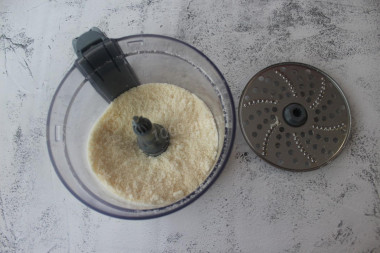
Finely grate the parmesan. There are two options here. The first: using a kitchen grater, pre-cooled, so the cheese will be easier to grate. Second: using a blender, cut the parmesan into cubes and grind it in a blender using a disk with a fine grater. Cheese cannot be grated on a large grater, since the sauce must be homogeneous, we do not need floating pieces of cheese in the sauce.
Step 6:
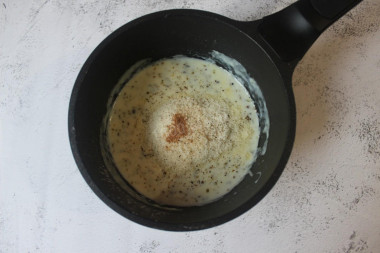
Add grated cheese to the sauce, season with salt and pepper, add a pinch of nutmeg and mix. Be careful with the amount of salt, as the parmesan itself is quite salty. Remove the sauce from the heat and cool slightly before use. Apply the finished sauce to the pizza base, a little short of its edges. If the sauce is very thick and it is difficult to put it on the pizza, just put it back on the stove and warm it up slightly.
The following products are perfectly combined with this white sauce: champignons, bell peppers, spinach, asparagus, tuna, salmon, all kinds of seafood: shrimp, squid, octopus.
It is worth paying attention to the quality of the seasoning. Using poor-quality seasoning, I ruined the sauce. The seasoning gave a swampy shade, and my sauce changed color. Be very careful!
From this amount of ingredients, I got such a small jar of sauce. It was enough for me for 4 pizzas with a diameter of 22.5 cm. But it is also worth considering that everyone uses the sauce differently: someone puts a lot of sauce on the dough, and someone only lightly lubricates it.
If you use ready-made spice mixes, be sure to read the composition on the package. Often, salt is already present in such mixtures, take this into account, otherwise you risk over-salting the dish.
Caloric content of the products possible in the composition of the dish
- Whole cow's milk - 68 kcal/100g
- Milk 3.5% fat content - 64 kcal/100g
- Milk 3.2% fat content - 60 kcal/100g
- Milk 1.5% fat content - 47 kcal/100g
- Concentrated milk 7.5% fat content - 140 kcal/100g
- Milk 2.5% fat content - 54 kcal/100g
- Dutch cheese - 352 kcal/100g
- Swiss cheese - 335 kcal/100g
- Russian cheese - 366 kcal/100g
- Kostroma cheese - 345 kcal/100g
- Yaroslavsky cheese - 361 kcal/100g
- Altai cheese 50% fat content - 356 kcal/100g
- Soviet cheese - 400 kcal/100g
- Cheese "steppe" - 362 kcal/100g
- Uglichsky cheese - 347 kcal/100g
- Poshekhonsky cheese - 350 kcal/100g
- Lambert cheese - 377 kcal/100g
- Appnzeller cheese with 50% fat content - 400 kcal/100g
- Chester cheese with 50% fat content - 363 kcal/100g
- Edamer cheese with 40% fat content - 340 kcal/100g
- Cheese with mushrooms of 50% fat content - 395 kcal/100g
- Emmental cheese with 45% fat content - 420 kcal/100g
- Gouda cheese with 45% fat content - 356 kcal/100g
- Aiadeus cheese - 364 kcal/100g
- Dom blanc cheese (semi-hard) - 360 kcal/100g
- Lo spalmino cheese - 61 kcal/100g
- Cheese "etorki" (sheep, hard) - 401 kcal/100g
- White cheese - 100 kcal/100g
- Fat yellow cheese - 260 kcal/100g
- Altai cheese - 355 kcal/100g
- Kaunas cheese - 355 kcal/100g
- Latvian cheese - 316 kcal/100g
- Limburger cheese - 327 kcal/100g
- Lithuanian cheese - 250 kcal/100g
- Lake cheese - 350 kcal/100g
- Gruyere cheese - 396 kcal/100g
- Garlic - 143 kcal/100g
- Ground black pepper - 255 kcal/100g
- Whole durum wheat flour fortified - 333 kcal/100g
- Whole durum wheat flour, universal - 364 kcal/100g
- Flour krupchatka - 348 kcal/100g
- Flour - 325 kcal/100g
- Butter 82% - 734 kcal/100g
- Amateur unsalted butter - 709 kcal/100g
- Unsalted peasant butter - 661 kcal/100g
- Peasant salted butter - 652 kcal/100g
- Melted butter - 869 kcal/100g
- Salt - 0 kcal/100g
- Oregano dry - 306 kcal/100g
- Nutmeg - 556 kcal/100g

